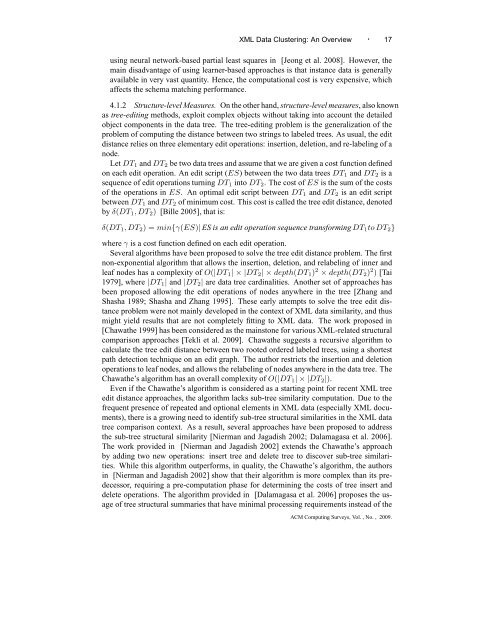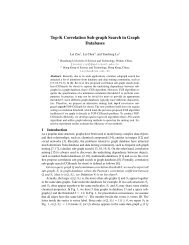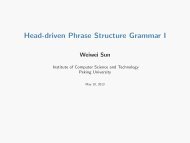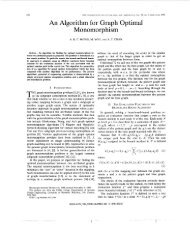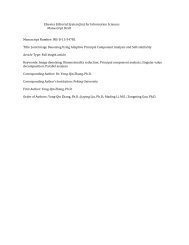PDF (1MB) - QUT ePrints
PDF (1MB) - QUT ePrints
PDF (1MB) - QUT ePrints
You also want an ePaper? Increase the reach of your titles
YUMPU automatically turns print PDFs into web optimized ePapers that Google loves.
XML Data Clustering: An Overview · 17<br />
using neural network-based partial least squares in [Jeong et al. 2008]. However, the<br />
main disadvantage of using learner-based approaches is that instance data is generally<br />
available in very vast quantity. Hence, the computational cost is very expensive, which<br />
affects the schema matching performance.<br />
4.1.2 Structure-level Measures. On the other hand, structure-level measures, also known<br />
as tree-editing methods, exploit complex objects without taking into account the detailed<br />
object components in the data tree. The tree-editing problem is the generalization of the<br />
problem of computing the distance between two strings to labeled trees. As usual, the edit<br />
distance relies on three elementary edit operations: insertion, deletion, and re-labeling of a<br />
node.<br />
Let DT 1 and DT 2 be two data trees and assume that we are given a cost function defined<br />
on each edit operation. An edit script (ES) between the two data trees DT 1 and DT 2 is a<br />
sequence of edit operations turning DT 1 into DT 2 . The cost of ES is the sum of the costs<br />
of the operations in ES. An optimal edit script between DT 1 and DT 2 is an edit script<br />
between DT 1 and DT 2 of minimum cost. This cost is called the tree edit distance, denoted<br />
by δ(DT 1 , DT 2 ) [Bille 2005], that is:<br />
δ(DT 1 , DT 2 ) = min{γ(ES)| ES is an edit operation sequence transformingDT 1 toDT 2 }<br />
where γ is a cost function defined on each edit operation.<br />
Several algorithms have been proposed to solve the tree edit distance problem. The first<br />
non-exponential algorithm that allows the insertion, deletion, and relabeling of inner and<br />
leaf nodes has a complexity of O(|DT 1 | × |DT 2 | × depth(DT 1 ) 2 × depth(DT 2 ) 2 ) [Tai<br />
1979], where |DT 1 | and |DT 2 | are data tree cardinalities. Another set of approaches has<br />
been proposed allowing the edit operations of nodes anywhere in the tree [Zhang and<br />
Shasha 1989; Shasha and Zhang 1995]. These early attempts to solve the tree edit distance<br />
problem were not mainly developed in the context of XML data similarity, and thus<br />
might yield results that are not completely fitting to XML data. The work proposed in<br />
[Chawathe 1999] has been considered as the mainstone for various XML-related structural<br />
comparison approaches [Tekli et al. 2009]. Chawathe suggests a recursive algorithm to<br />
calculate the tree edit distance between two rooted ordered labeled trees, using a shortest<br />
path detection technique on an edit graph. The author restricts the insertion and deletion<br />
operations to leaf nodes, and allows the relabeling of nodes anywhere in the data tree. The<br />
Chawathe’s algorithm has an overall complexity of O(|DT 1 | × |DT 2 |).<br />
Even if the Chawathe’s algorithm is considered as a starting point for recent XML tree<br />
edit distance approaches, the algorithm lacks sub-tree similarity computation. Due to the<br />
frequent presence of repeated and optional elements in XML data (especially XML documents),<br />
there is a growing need to identify sub-tree structural similarities in the XML data<br />
tree comparison context. As a result, several approaches have been proposed to address<br />
the sub-tree structural similarity [Nierman and Jagadish 2002; Dalamagasa et al. 2006].<br />
The work provided in [Nierman and Jagadish 2002] extends the Chawathe’s approach<br />
by adding two new operations: insert tree and delete tree to discover sub-tree similarities.<br />
While this algorithm outperforms, in quality, the Chawathe’s algorithm, the authors<br />
in [Nierman and Jagadish 2002] show that their algorithm is more complex than its predecessor,<br />
requiring a pre-computation phase for determining the costs of tree insert and<br />
delete operations. The algorithm provided in [Dalamagasa et al. 2006] proposes the usage<br />
of tree structural summaries that have minimal processing requirements instead of the<br />
ACM Computing Surveys, Vol. , No. , 2009.


